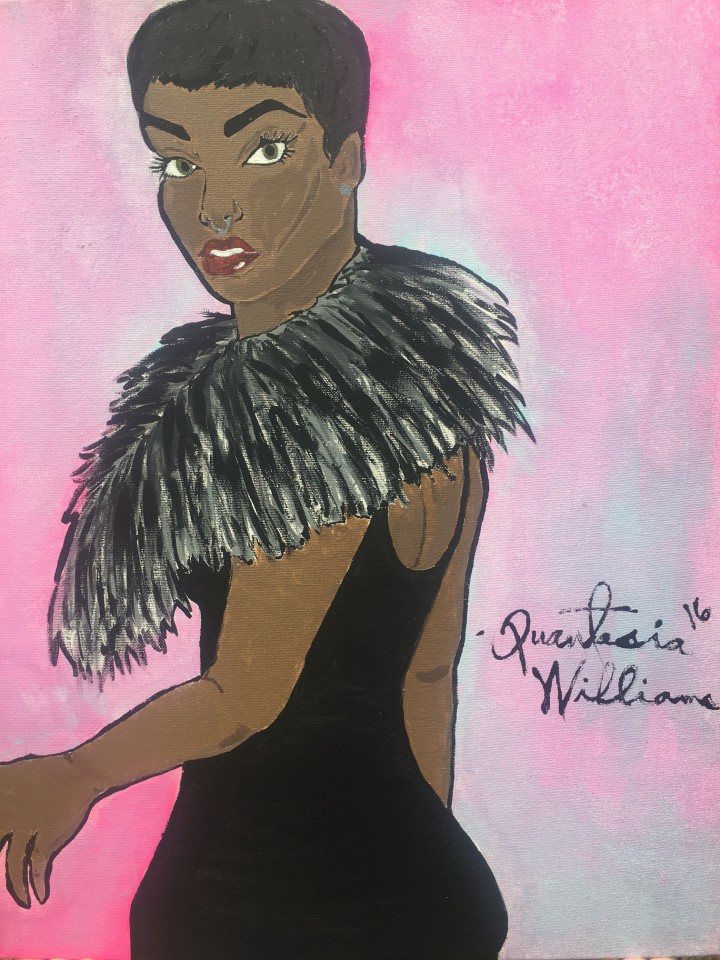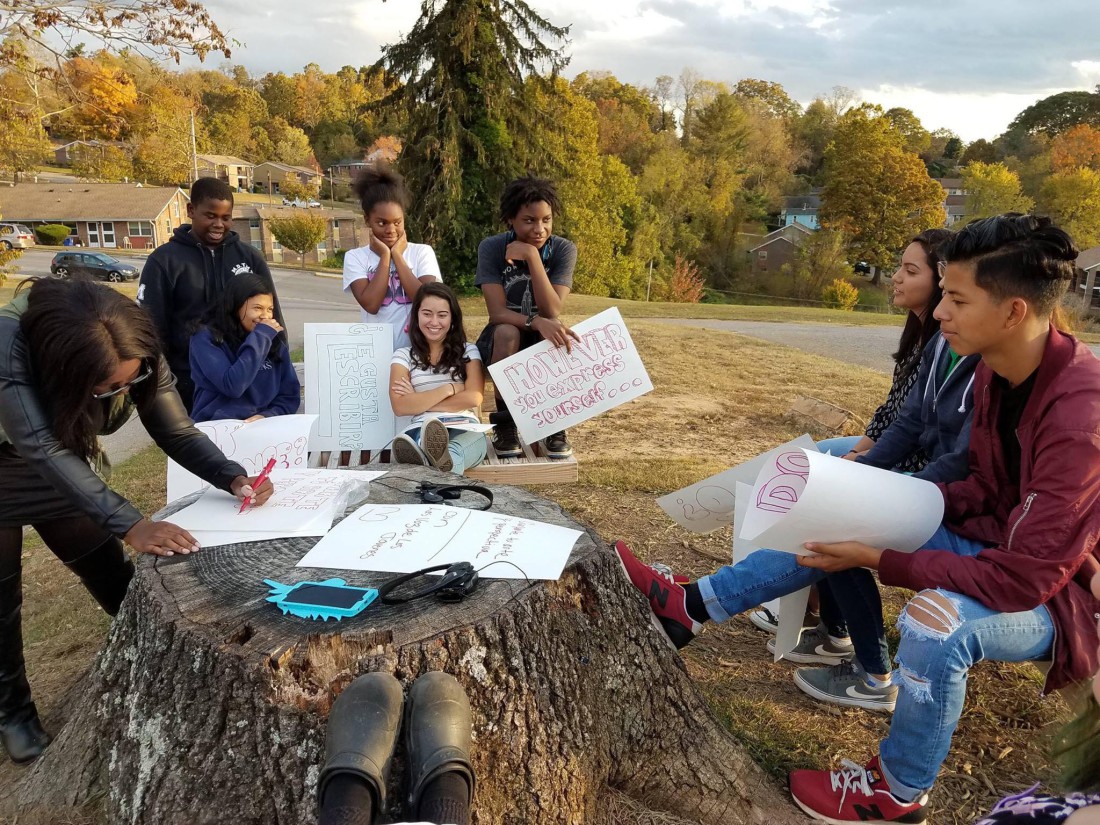With the pilot launch of Word on the Street — a bilingual, multimedia online magazine created by students of the Asheville Writers in the Schools & Community-created program — “We’re asking the youth to show us their talents,” says squad member Serenity Lewis. “We’re getting the youth to think critically about what they see and how to put it into their artwork. … how does this dance video connect to you and what you want to say through your dancing and how that song expresses you.” Word on the Street is teaming up with High Five Coffee on a latte art competition, which takes place Thursday, Jan. 12.
Lewis, a high school student, is part of the magazine’s design team. Other departments, carrying out tasks from editing to marketing, are helmed by students from various middle and high schools, as well as some who are home-schooled. Word on the Street is volunteer-run. A $500 grant from All Souls Cathedral Outreach Committee helped with the purchase of simultaneous interpretation technology — headsets so that everyone can understand what’s being said.
“Initially we didn’t know we’d have monolingual Spanish speakers who would want to be part of the program,” says AWITSC teaching artist and writer Tamiko Ambrose Murray. The Center for Participatory Change helped with accessing equipment and setting it up. That unique aspect of Word on the Street’s operation likely makes it the only program of its kind in the country.

“The space that we’ve created is called a language justice space,” Murray continues. “That means there is no ‘other’ language. Everybody’s voice, no matter what language they speak, is equally valued.”
Also equally valued are all the many talents it takes to create a magazine. Although art is what’s featured, those working behind the scenes hone the necessary skills to envision, create and manage the web-based publication. About half of the students involved identify themselves as artists — Lewis, for example, has studied African and hip-hop dance and is also a visual artist and photographer — but their focus with Word on the Street deals with videography, layout, reviewing submissions, editing and other tasks. “It’s an arts magazine, and they’re holding that space,” Murray explains.
The students also created the infrastructure for the publication during a weekendlong learning retreat in Hot Springs. “Before that, we didn’t really know each other,” says squad member Tanya Davilia. The program was originally intended for 10 students. Seventeen were accepted to the squad, and currently 16 staff the magazine.
During the retreat, “We got to know, ‘Why are we here? Why are we doing this?’” says Davilia. “We all had different answers.”
“We had to adjust from translating to agreeing to disagree,” says Zyá Brown, another member of the Word on the Street squad. “I know I’d get frustrated when someone didn’t understand what I was saying. But now that we’ve adapted, it’s easier.”
At a two-week summer institute, held at the Arthur R. Edington Education & Career Center, where the teams meet weekly, “We made a family outside of our own family,” says Lewis.
From that basis of trust and understanding, the students hope to inspire other young people. “Everyone’s voice matters, no matter how young or how old,” says Brown. “A lot of times people of color — Hispanic, African-American — because we’re considered minorities, sometimes [we feel like] we don’t matter as much.”
But Word on the Street offers a platform for self-expression and a place where those voices not only count but find an audience. “It makes me proud of being Mexican and embracing that and bringing it to the table,” says Davilia.
From its inception, the project “felt really, really good,” says Word on the Street coordinator Daniel Suber. “It’s very powerful, and every bit of it is valuable. It teaches me a lot.”
Most important to Suber is “keeping the young people involved — they are Word on the Street.”
To increase awareness about the magazine, which was preparing to publish its first full online issue at press time, the marketing team has been making connections in the community. That group — Davilia, Brown and two other students — forged a cross-promotional relationship with High Five Coffee for its Thursday Night Throwdown. In the competition, baristas go head to head to see who can produce the prettiest designs with steamed milk and espresso. Word on the Street squad member Quantasia Williams designed the flier for the event, where the $5 buy-in benefits the teen-produced magazine and also showcases yet another form of creativity.
Plus, even for those who aren’t competing, DJ Lil’ Meow Meow will spin dance music all evening — it’s the perfect setting to cheer on the latte artists and the talented team behind Asheville’s new bilingual arts magazine.
Learn more at wordonthestreetmag.org
WHAT: Thursday Night Throwdown latte art competition with music by DJ Lil’ Meow Meow
WHERE: High Five Coffee, 190 Broadway, highfivecoffee.com
WHEN: Thursday, Jan. 12, 6-9 p.m. $5 for baristas to enter, proceeds benefit Word on the Street




” . . . simultaneous interpretation technology — headsets so that everyone can understand what’s being said. . .”
How does this technology work? Are any humans involved in doing the simultaneous translation?
I don’t know how the simultaneous interpretation equipment works exactly, but there are lots of business suppliers that provide that sort of equipment for conferences, courtrooms and meetings. There are various set ups including sound booths and discussion systems (you can see some of the options here: http://www.lexicon-global.com/Translation-Equipment/Translation-Equipment-Rental.html). There’s not a human interpreter.
Would not
‘how that technology works’ be something to research pre- publishing an article or at least promising to do as a follow up instead of simply posting a link which may or may not supply posters like Curious with a definitive answer?
It would in the case of a tech article about simultaneous interpretation equipment. Since this is an arts article about an initiative by local teens, I opted to budget my time on interviewing the teens, visiting their program and checking out their magazine.
Thanks for that helpful information.